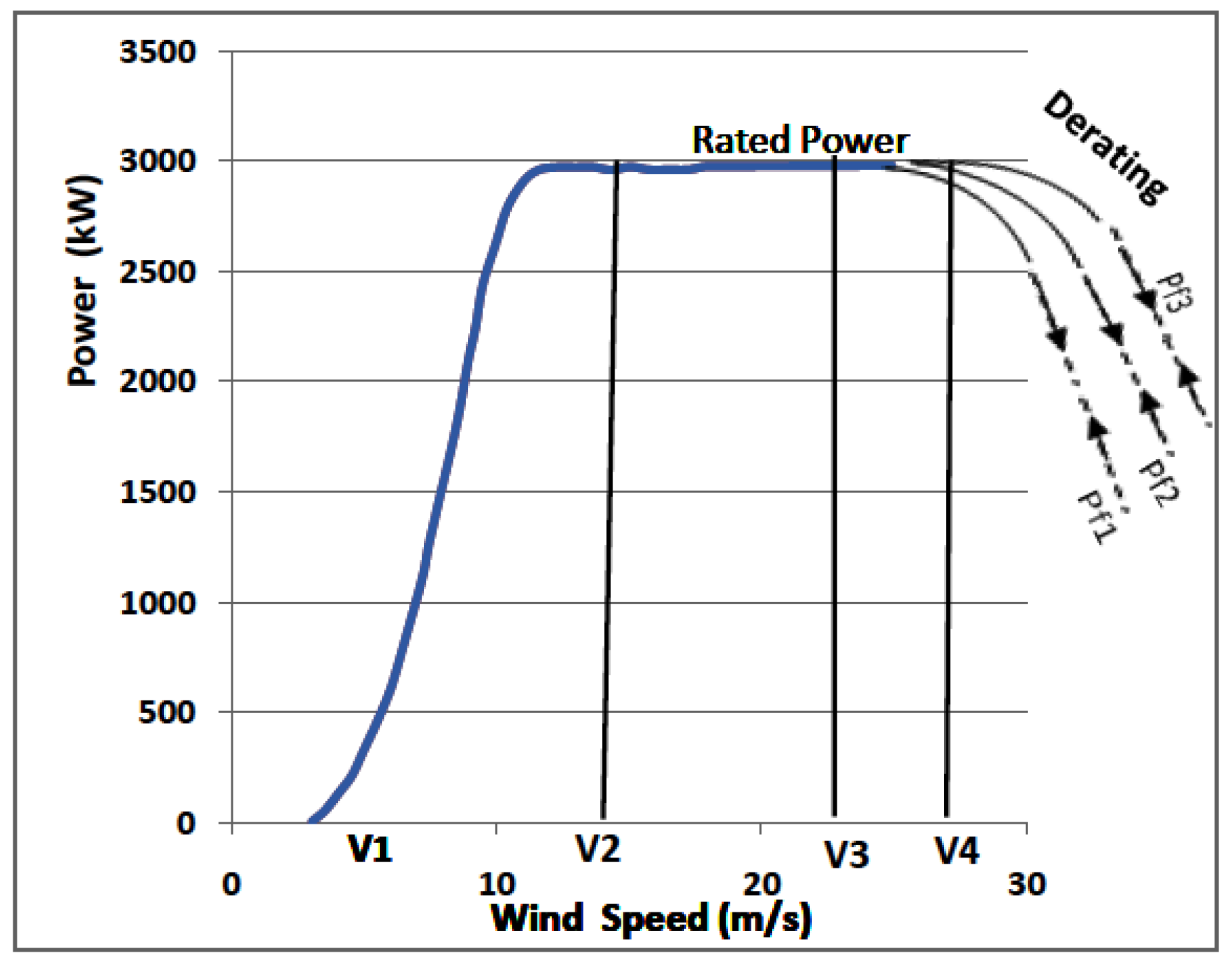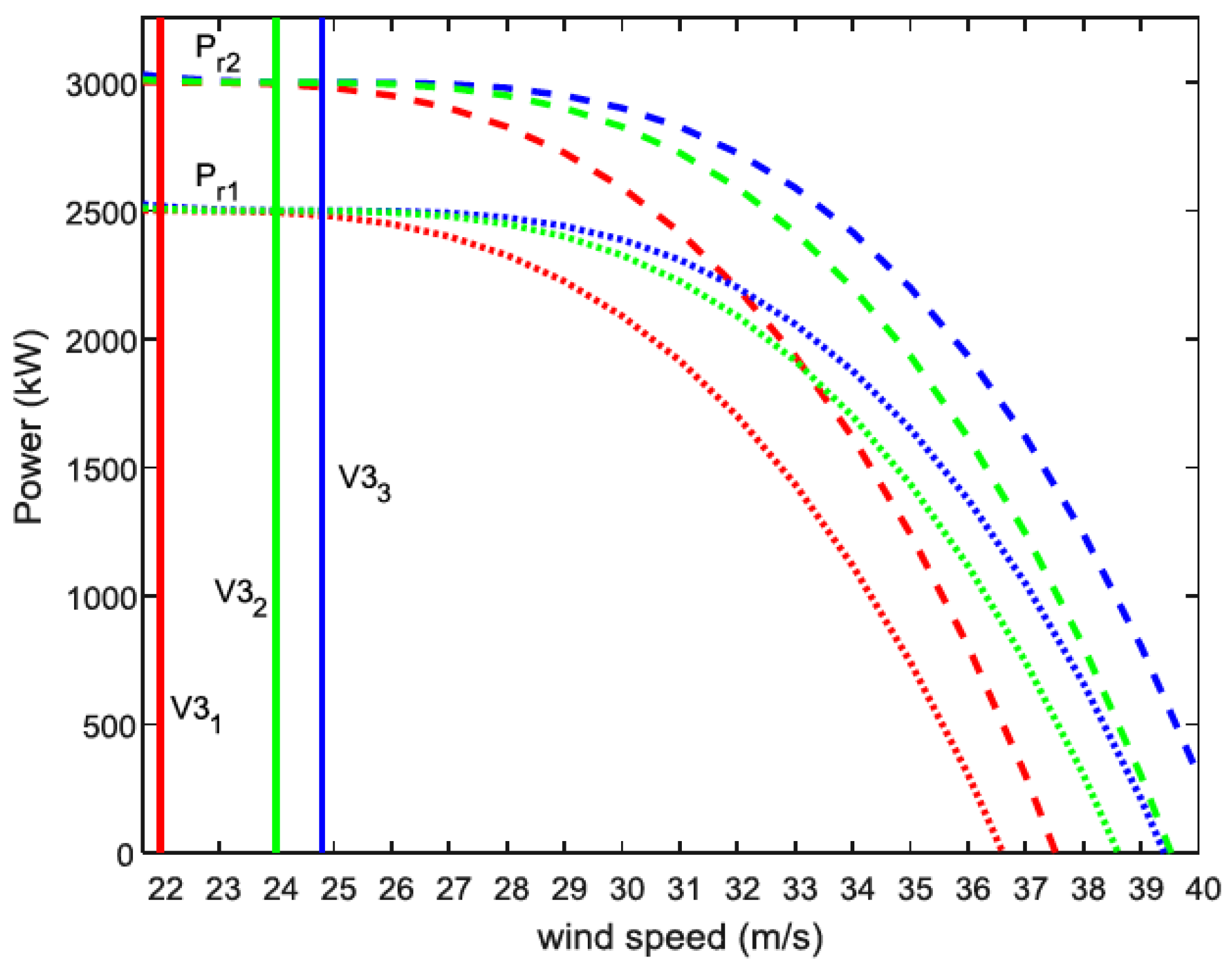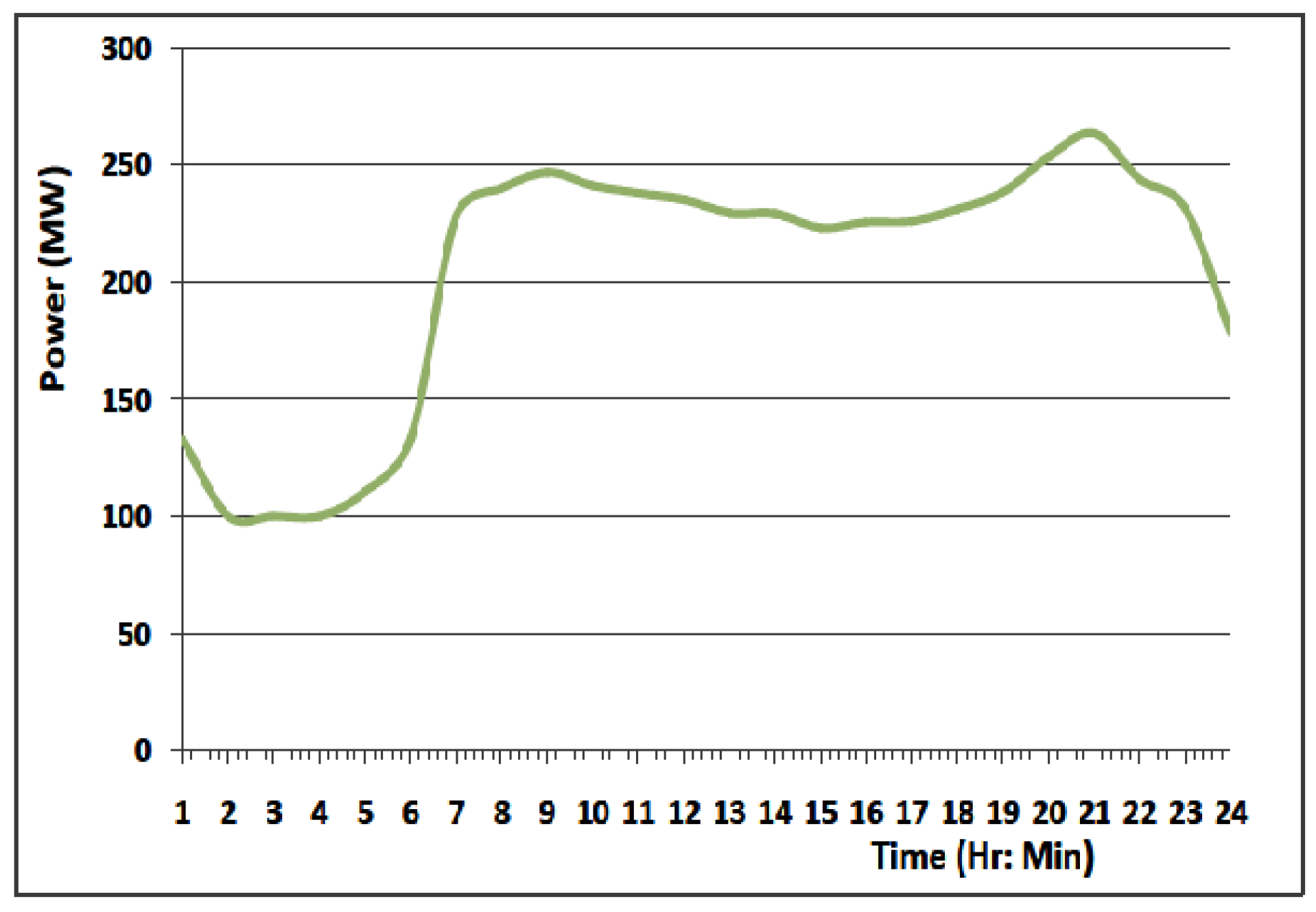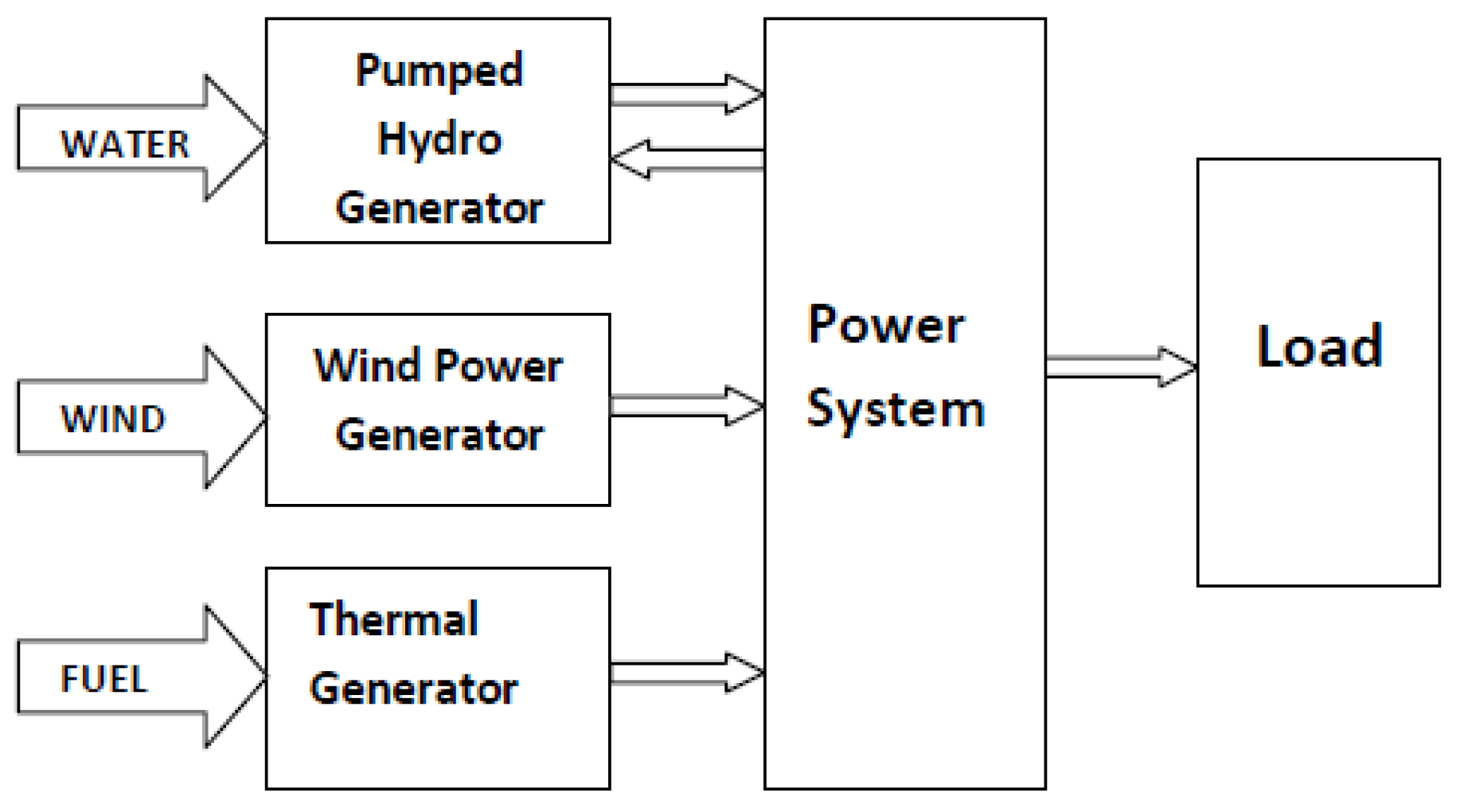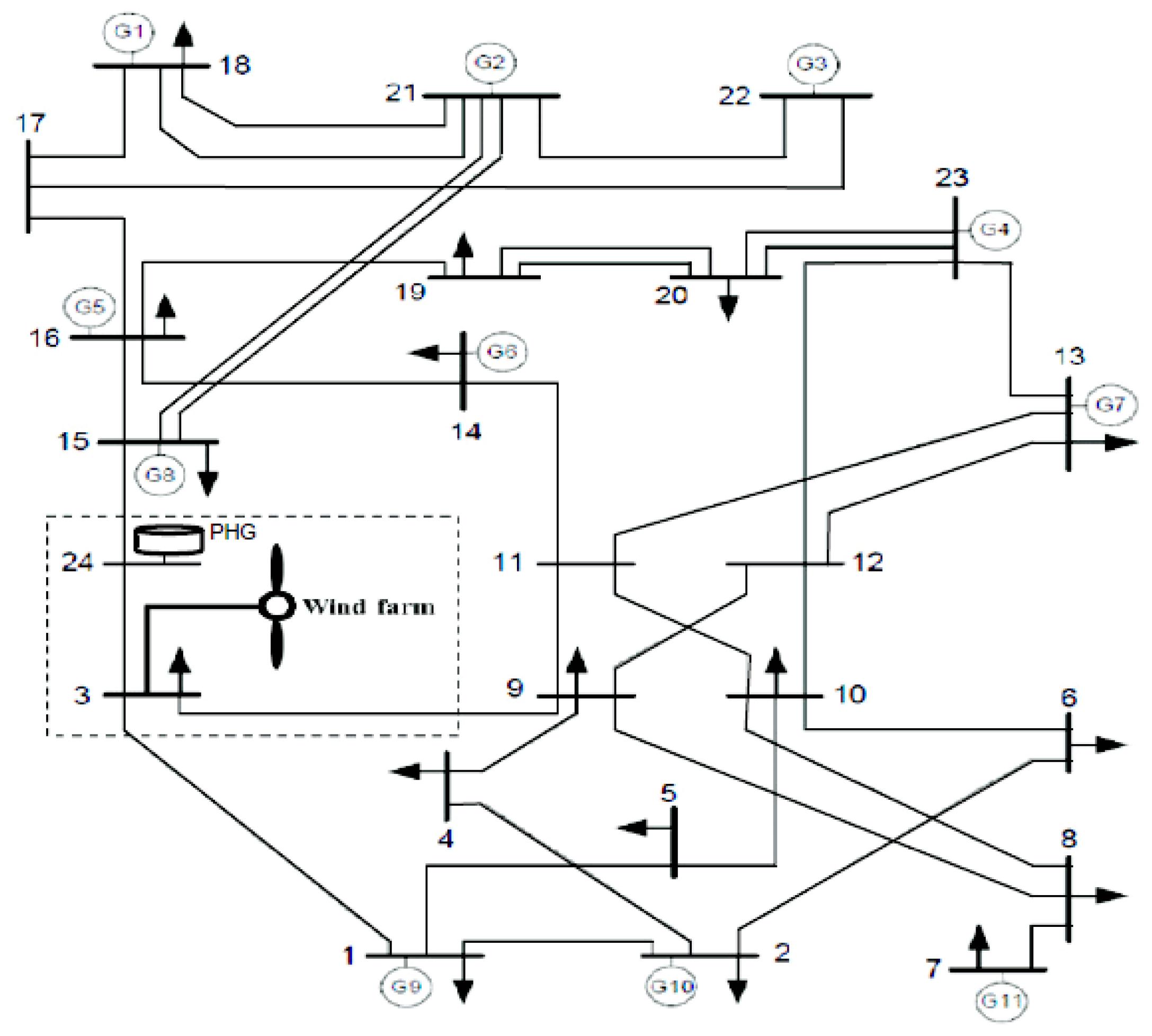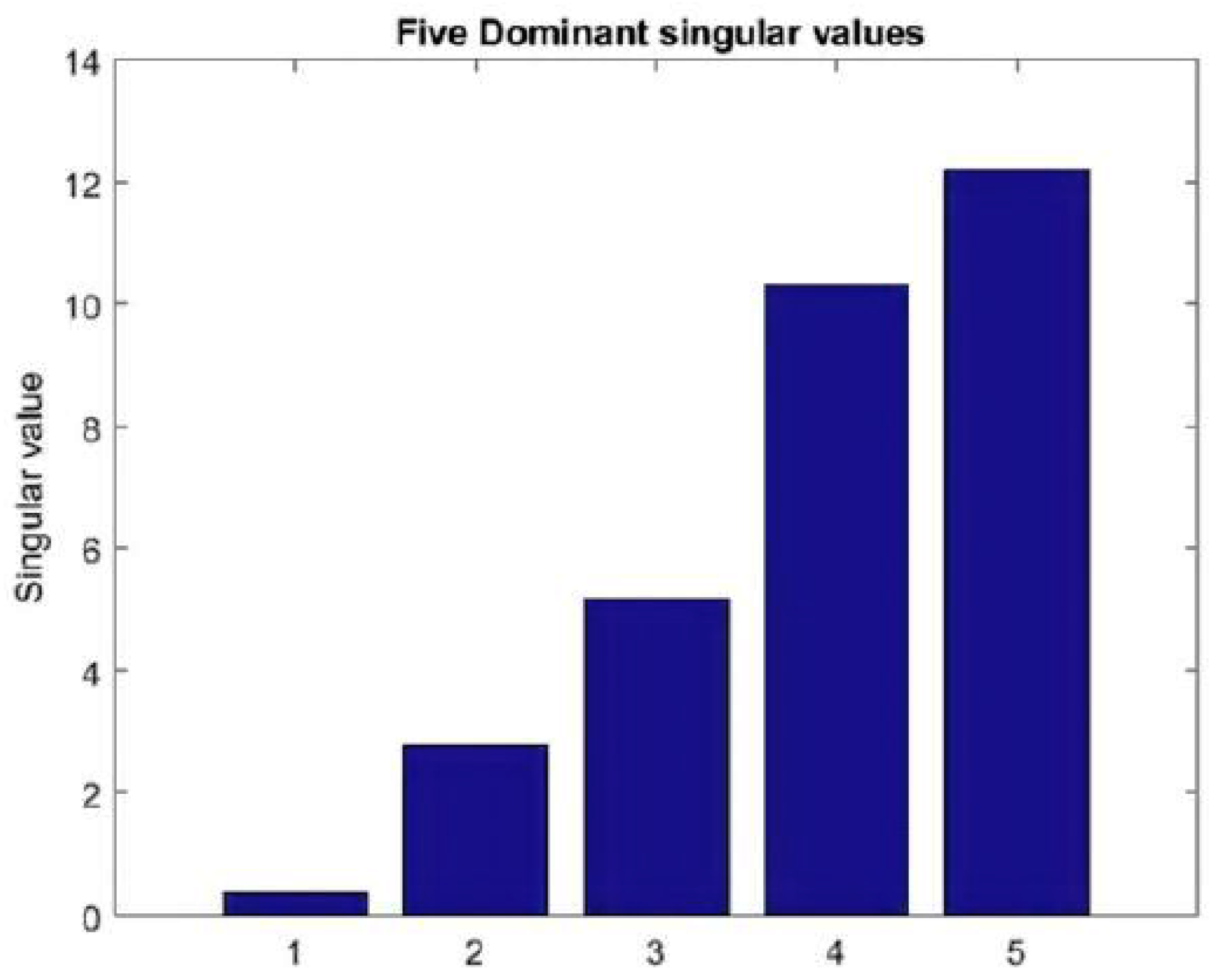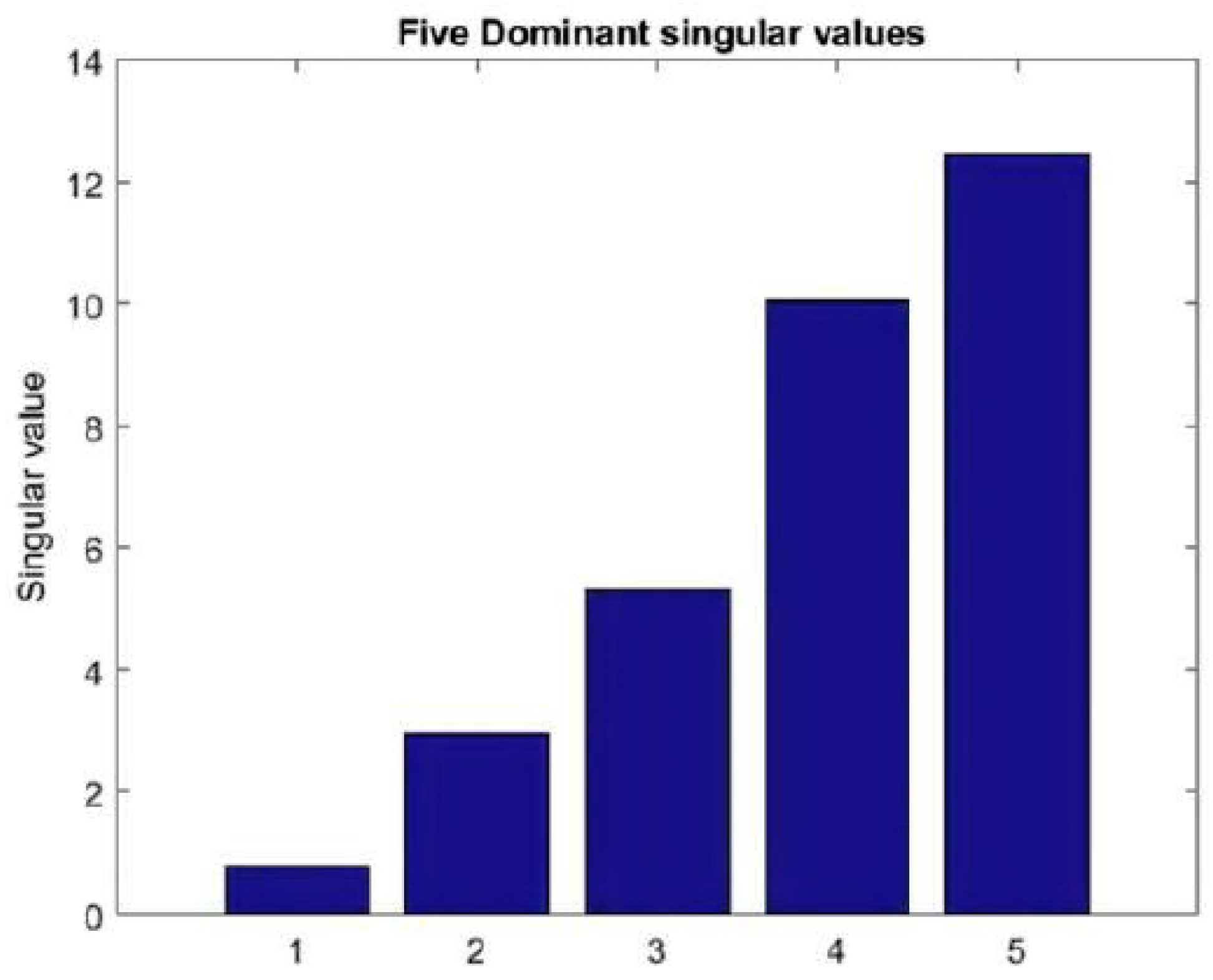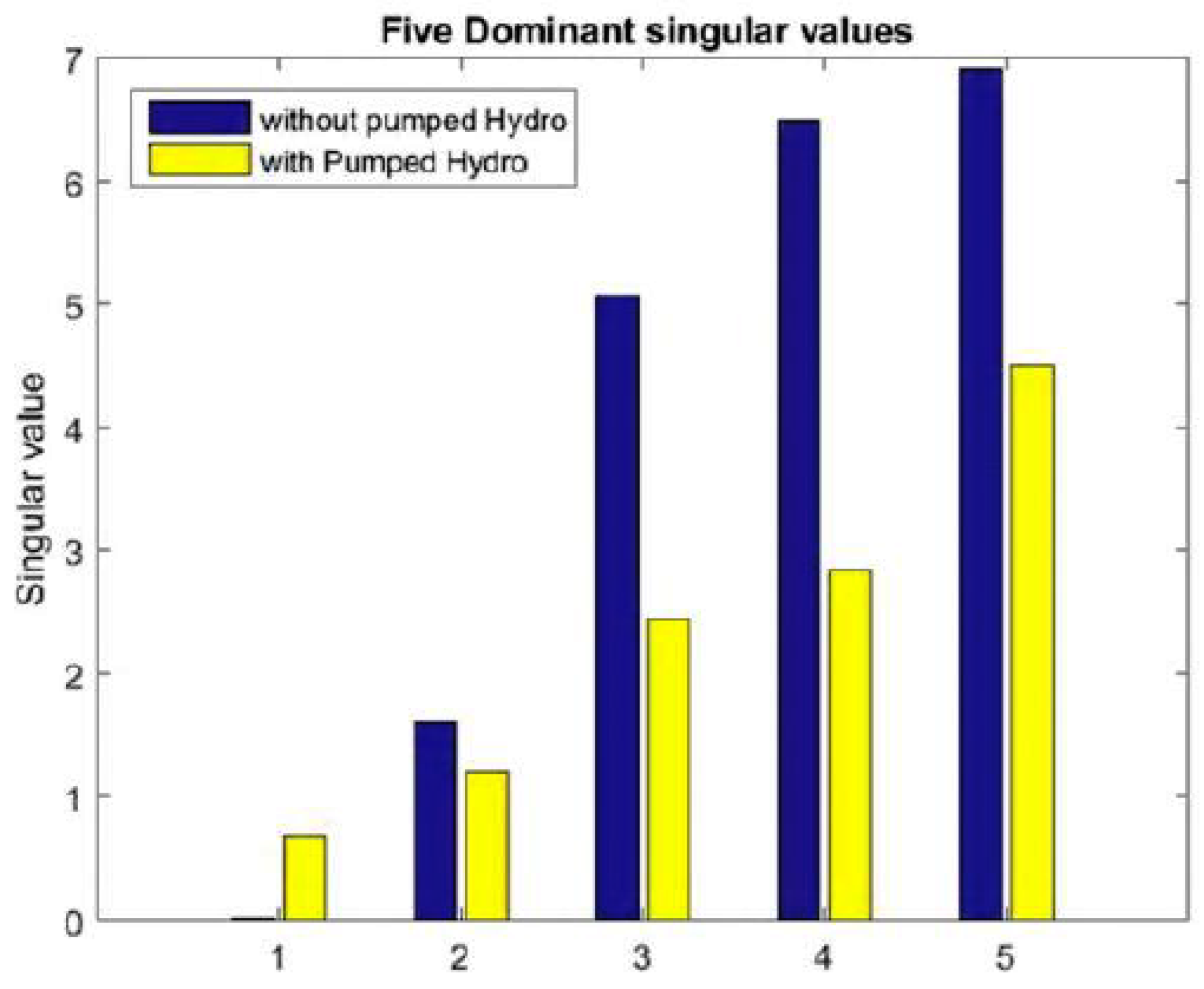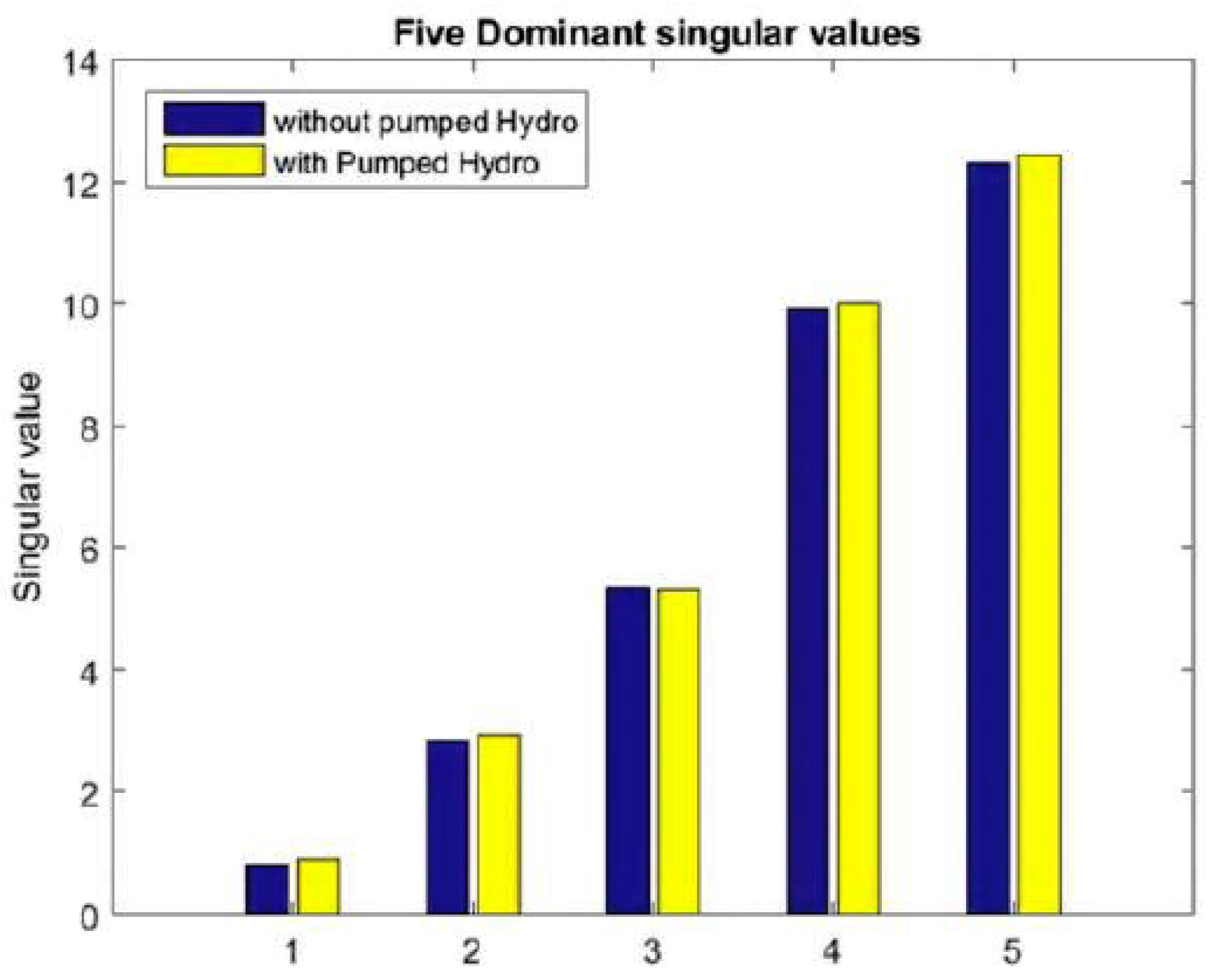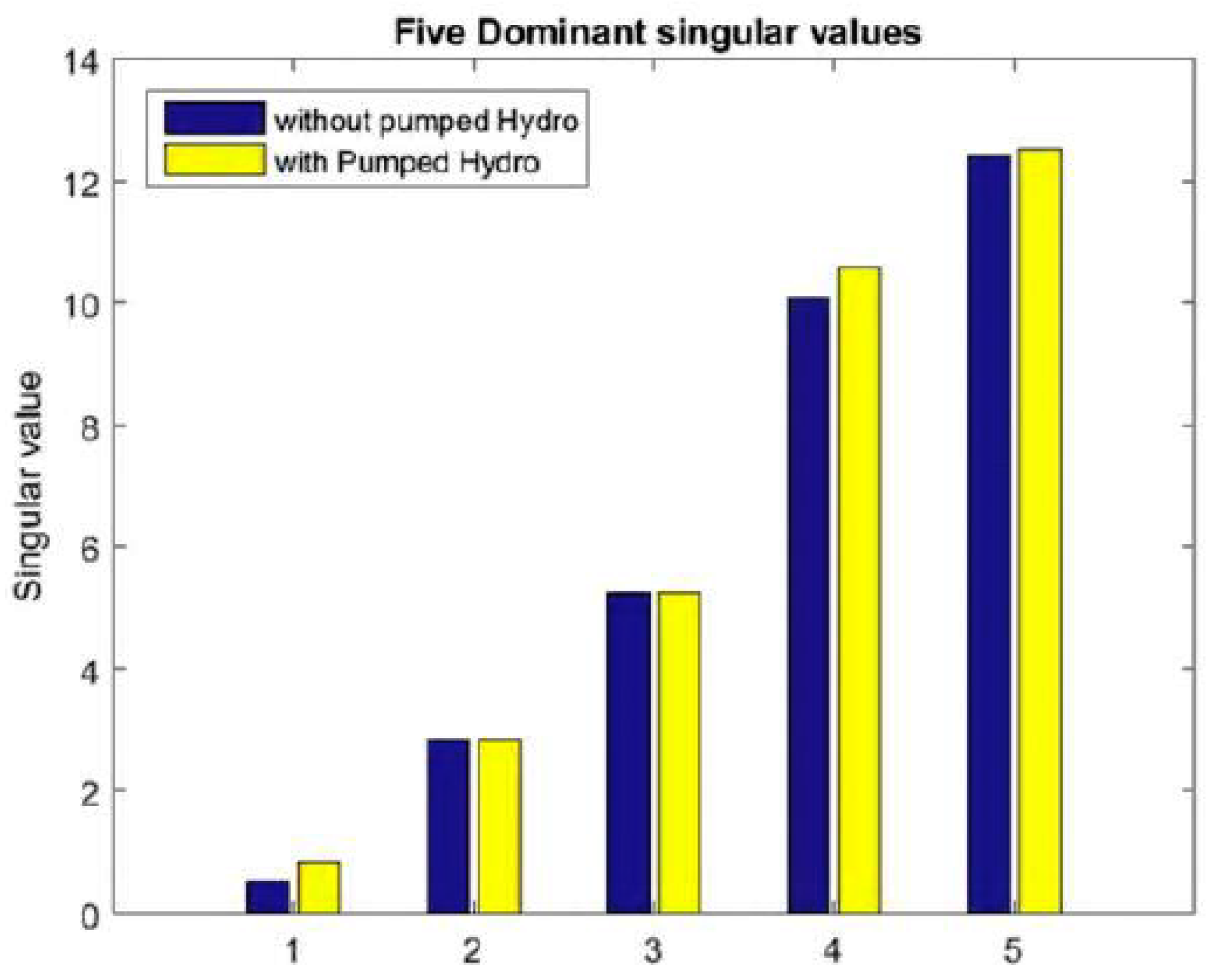When wind power curtailment becomes inevitable under high wind speed above cut-off, PHG is used for effective wind generation withdrawal from the power system operation. The power balance equation considering the PHG involvement on the power system operation before and during withdrawal of wind generation is, therefore, considered under two modes (power conservation and generation) given as follows,
4.1. Operating the Wind Turbine above the Cut-Off Speed
The wind turbine power generation normally operates on four regions as shown on the curve given in
Figure 1. These are defined by Equation (
23) as modified from the work by the authors of [
19] as follows,
where,
= Constant
P = Wind turbine generated power []
= Wind turbine rated power []
= Wind turbine rated speed
= Maximum power coefficient
= Air density
A = Turbine blade sweep area
V = Wind speed
= Cut-in wind speed
= Cut-off wind speed
On the second region of wind turbine operation, which starts from and ends at the rated turbine power (), the output power (P) follows a cubic power of the wind speed . From speed , irrespective of the wind speed change, the rated power is then maintained until the speed reaches cut-off, , when the blades are turned away from the wind front and the power generation ceases completely.
The wind turbine needs to be operated above the cut-off speed to avoid the impact of sudden power fallout from wind generation at the rated value (
); when the cut-off speed (
) is attained during high wind speeds, shutdown is required. This, if ignored, may also lead to possible wind turbine migration into a hysteresis loop as shown in
Figure 2; when the wind speed briefly returns to a normal rated speed after overshooting the cut-off, possibly several times. Abrupt generation shutdown may also have devastating effects on the stability of the power system and wind turbine. A delay in the cut-off point is achievable by extending the normal cut-off speed limit.
Modification of the blade’s pitch angle and rotor speed controls allows continued operation of the the wind turbine at power levels below the rated power (derating) during high wind speed, thereby maintaining generation at lower output power (ramping down), such that it could safely return to the rated operation at
, when again the wind speed falls (ramping up) below the cut-off speed briefly, as shown in
Figure 3. This figure illustrates the curves resulting from the wind turbine system modification of the blade pitch angle and rotor control sections. This results in the wind turbine operating on a power output below the rated value (derating) beyond the preset wind speed limit (V3). The curves designated
,
, and
represent variation of V3 (
,
, and
, respectively) for different selections on the turbine power curve modification. These curves postpone the onset of cut-off point, thereby allowing sufficient time for start-up of the PHG and completion of power switchover process. This eliminates the intermittence at high wind speeds beyond the cut-off.
Implementing such modification to the turbine control systems, as discussed in works by the authors of [
20,
21,
22], transforms the normal wind turbine power curve in
Figure 1 to an extended power curve version beyond the cut-off point, as shown in
Figure 3. This ensures safe turbine operation within normal and beyond the cut-off regions and smooth power switchover from the wind power generation to the PHG when curtailment becomes unavoidable beyond certain point.
PHG has the capacity to attain maximum power output within 60 to 90 s of start-up. Therefore, the effective power switchover could take place within the range of the extended wind turbine curve operation on the sub-hourly dispatch power system operation.
In this work, a specific wind turbine is considered: model SL 3000/90, manufactured by Sinovel (China) and installed in a wind farm at Dassiesklip (Western Cape), South Africa. The technical specifications of the turbine are given in
Table 1.
Assuming the rising edge of the wind turbine curve from cut-in (
) and the falling edge (beyond
) follow similar power generation characteristics to those shown in
Figure 3, then the modified region of the turbine extended power curve is expressed by Equation (
24) as follows,
Simplifying Equation (
24), gives
By selecting different power derating starting points (
), (i.e.,
,
,
, etc.) and also considering wind turbines with different rated power specifications (
), (i.e.,
,
, etc.), then the derating power curve,
, changes accordingly as shown in
Figure 3 and
Figure 4, and expressed in Equations (
26)–(
28), respectively, as follows,
For wind turbine rated power,
=
, with different starting points for
(i.e.,
,
, and
), then the power derating curves,
, (i.e.,
,
, and
) are expressed respectively as follows,
where,
= A
= 0.5 (0.5 = Belz constant, = generator efficiency, = rotor bearing efficiency)
< < <
= Wind turbine rated power
= Preset power derating starting wind speed
= Maximum preset wind speed on the power derating range
= Wind speed difference between current speed, V, and for a wind plant,
= Wind power generation beyond cut-off point (derating)
The expanded power derating region is as shown in
Figure 4 for two wind turbine models with rated powers
and
.
Assume = 2500 kW and = 3000 kW. ( was used in the simulation.)
The power system effective mechanism for power switchover between wind generation and the PHG is based on . Therefore, the allowable wind turbine power ramping, , beyond the cut-off point is a function of rated power, , and wind speed, V.
It could be deduced from
Figure 3 that appropriate action needs to be taken beyond the wind turbine cut-off point,
/
, on the
region, so that the power switchover to PHG on the power system is effectively accomplished.
On a normal wind turbine curve, the wind power available for harnessing is from the cut-in speed (/) to cut-off speed (/), beyond which the energy is not harnessable because the turbine is turned off. However, on a wind turbine where modification of pitch and rotor controls has been implemented, the turbine continues to run beyond the cut-off point, , up to the preset derating limit, . The limit, , could be flexible depending on the extent of modification imposed on a specific wind turbine.
The wind speed range, (–), has another flexibility advantage for successful start-up of the PHG and effective switchover of power with the wind generation on the power system, which is due to the delay imposed on the normal wind generation cut-off point during high wind speeds. This also gives the benefit of avoiding the hysteresis mode in the wind turbine operation when the wind speed ramps up and down around the cut-off speed limit and the normal range of operation.
4.3. Stability Analysis Using Singular Value Decomposition
A number of methods for power system stability analysis are given in works by the authors of [
25,
26,
27]. However, each method has its strength depending on the specific issue under consideration.
In this work, the impact of the intermittence and the proposed solutions on the power system operation are analyzed using the Singular Value Decomposition (SVD) method on different scenarios. SVD has been used in many research works to analyze power system stability problems, as in the work by the authors of [
28].
The equations describing the SVD computation analysis carried out are presented; thus, the difference between the specified real power and the estimated power
and between the specified reactive power and the estimated value
can be expressed as a function of the correction factors in the voltage magnitude
and voltage angle
by making use of the Jacobian matrix
of the network. The relationships are summarized as given in Equations (
29) and (
30) as follows,
where,
J is the Jacobian matrix of the system network, given by
Equation (
29) is now expressed as
Assuming, the difference between the specified real power and the estimated power, = 0.
Then, Equation (
31) is given as
Evaluating,
from Equation (
32), gives
Then from Equation (
33), the reduced jacobian,
, is given as
therefore,
When SVD is applied to the reduced Jacobian matrix (
), which is a real square matrix of
dimension, it is expressed as
where,
n = number of buses
= diagonal matrix with positive singular values, , , …, , in descending order
= left orthogonal matrix ( dimension)
= right orthogonal matrix ( dimension)
The minimum singular value (MSV) of the Jacobian matrix () determines the proximity of a bus system to singularity. The smaller singular value and the corresponding maximum singular vector () describe the buses ranking towards voltage singularity. is the last column of matrix .


